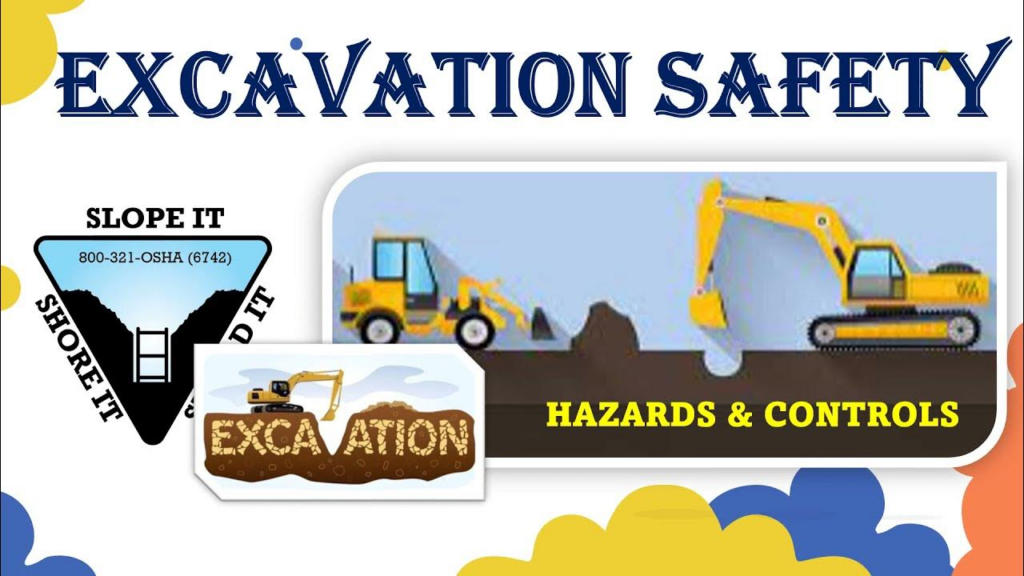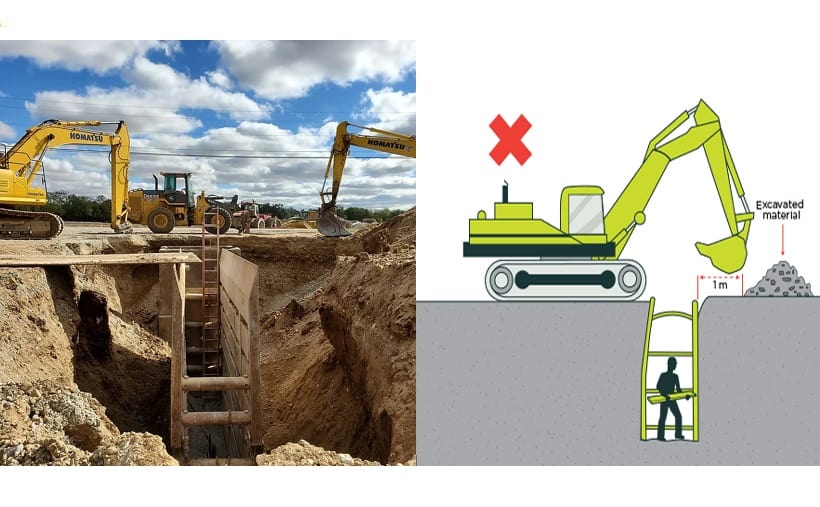TOP 30 EXCAVATION HAZARDS

Working in excavations is risky because it’s easy for the ground to suddenly collapse, trapping workers and causing really bad accidents. Imagine if the walls
of a narrow trench you’re digging cave in on you, burying you under dirt and rocks—it’s super dangerous and can even lead to people getting hurt badly or
losing their lives. That’s why it’s very important for all of us working in these holes, trenches, tunnels, or, pits to follow strict safety rules and safe working
procedures be really careful to avoid these kinds of scary and catastrophic accidents.
The top 30 excavation hazards, each with a detailed explanation of the dangers associated with them:
Hazards
- Cave-Ins:
Cave-ins are perhaps the most life-threatening excavation hazard. A trench or excavation can collapse suddenly, burying workers beneath heavy soil and debris.
The danger is that rescue efforts are challenging, and victims may suffer from asphyxiation or severe injuries. - Falling Materials:
Falling materials, like tools, equipment, or soil, can pose a constant risk in excavations. These materials can drop into the excavation, potentially causing
injuries or fatalities to workers below. - Engulfment:
Engulfment is a terrifying hazard, where a worker is fully buried by soil or materials in the excavation. This situation can lead to suffocation or severe bodily
harm, and the worker’s chances of survival decrease rapidly. - Toxic Atmosphere:
Excavations sometimes contain hazardous gases or a lack of oxygen, creating a toxic atmosphere. Workers inside may face severe respiratory risks, including
unconsciousness and death, if they inhale these substances. - Utilities:
Accidental contact with underground utilities like gas, water, electric, or telecommunication lines can result in gas leaks, water disruptions, electric shock,
and even explosions. - Mobile Equipment:
The use of mobile equipment can result in collisions or workers being struck. These incidents can lead to life-threatening injuries, making traffic control measures essential. - Inadequate PPE:
The absence or improper use of personal protective equipment (PPE) exposes workers to various hazards. Without proper PPE, workers are vulnerable to head
injuries, falling debris, electrical shocks, and more. - Falling Workers:
Workers within an excavation are at risk of slips, trips, or falls, which can cause serious injuries. - Weather Conditions:
Excess moisture can lead to soil collapse and pose dangers to workers.
Excavation Hazards

- Unstable Soil:
Soil instability or shifting within the excavation can result in wall collapses or trench failures, placing worker safety at high-risk. - Lack of Inspection:
Failure to conduct regular site inspections can lead to hazards going unnoticed.
These unaddressed safety concerns can result in accidents. - Communication Failures:
Clear and open communication is critical to relaying safety concerns within the excavation team. Inadequate reporting of potential hazards can hinder timely
responses. - Inadequate Training:
Workers without proper training in excavation safety, including protective methods and equipment operation, are at significant risk. Lack of knowledge in
safety protocols can lead to accidents. - Unsafe Entry/Exit:
The absence of secure access points, like ladders or ramps, can hinder safe entry and exit from the excavation. Workers can become trapped inside without proper egress. - Heavy Machinery:
Equipment malfunction, operator errors, or insufficient training can lead to accidents involving heavy machinery near the excavation. - Unsupported Loads:
Excessive loads on trench walls can cause instability and collapse. These unsupported loads increase the risk of accidents. - Lack of Emergency Response:
Inadequate emergency plans and a lack of resources can delay rescue efforts in accidents. Quick and effective emergency response planning is essential to ensure the well-being of workers. - Lack of Warning Systems:
The absence of alarms, signs, or barriers can increase the risk of accidents, as unauthorized personnel may inadvertently enter the excavation. - Utility Strikes:
Damaging underground utilities, like gas, water, or electric lines, can lead to gas leaks, water disruptions, electric shock, or service outages. Utility locating and
safe excavation techniques are vital to prevent utility strikes. - Uncontrolled Traffic:
Unmanaged vehicular and pedestrian traffic near excavation sites can result in accidents and collisions, posing severe threats to worker safety. - Collapse of Adjacent Structures:
Excavations near existing buildings or structures can potentially lead to their collapse if not properly shored or supported, endangering workers and nearby individuals.
Excavational Hazards:
- Falling Objects from Adjacent Structures:
Materials or debris can fall from nearby buildings or structures into the excavation, creating hazards for workers below. - Trench Cave-Ins:
Trenches can experience partial cave-ins, trapping workers or causing them to become engulfed by the soil. These situations are incredibly dangerous, and
rescue efforts are challenging. - Flammable or Explosive Atmosphere:
Some excavations can contain flammable gases or substances, resulting in the potential for explosions or fires. Workers may experience burns, suffocation, or
severe injuries in such incidents. - High Water Table:
Excavations near a high-water table can rapidly fill with water, leading to drowning hazards for workers inside the trench or excavation. - Vehicular Collisions:
Uncontrolled vehicles near excavation sites can collide, injuring workers or causing significant property damage. - Poor Lighting:
Inadequate lighting in and around the excavation can lead to slips, trips, and falls,increasing the risk of injury.
- Confined Spaces:
Excavations with limited space can lead to confined space hazards, including poor air quality and the potential for engulfment or asphyxiation. - Rockfalls:
In rocky or unstable soil conditions, rockfalls can occur, injuring workers below or causing structural damage to protective systems. - Chemical Exposures:
Some excavations may unearth hazardous materials or chemicals that can lead to toxic exposure or chemical burns if not handled carefully. Proper protective
measures and monitoring are crucial to mitigating these dangers.
Knowing the risks that come with excavating, it’s crucial to have protective methods in place to keep everyone safe on the job. Protective methods are like
safety shields.These methods are tools and rules we use to prevent accidents and
make sure we can work in these trenches or pits, without getting hurt. These smart strategies help us do our job safely.



This list of excavation hazards is extremely comprehensive and highlights the critical risks workers face on-site. The detailed explanations provide great insight into the importance of safety measures and protective strategies. It’s clear that safety is a top priority, and your breakdown of each hazard is invaluable for anyone in the industry. Excellent work in raising awareness and promoting safe practices!